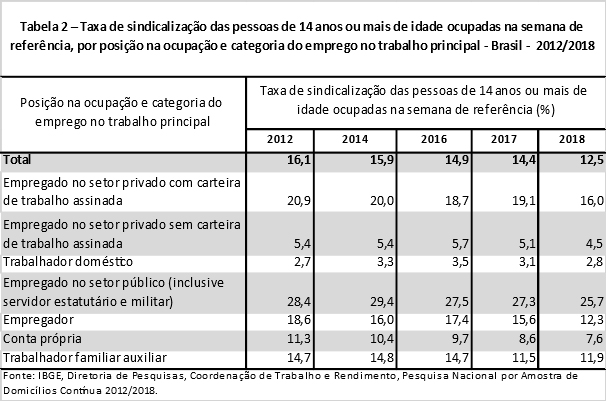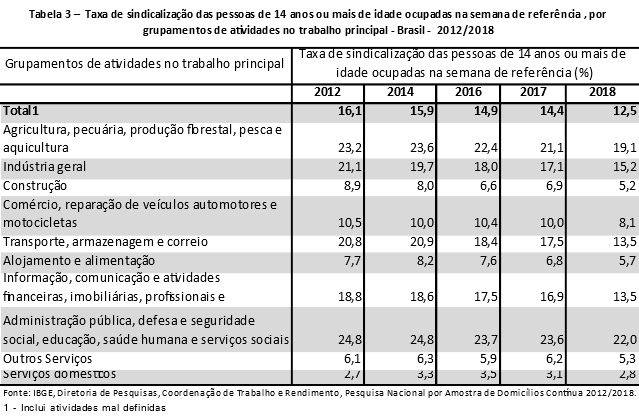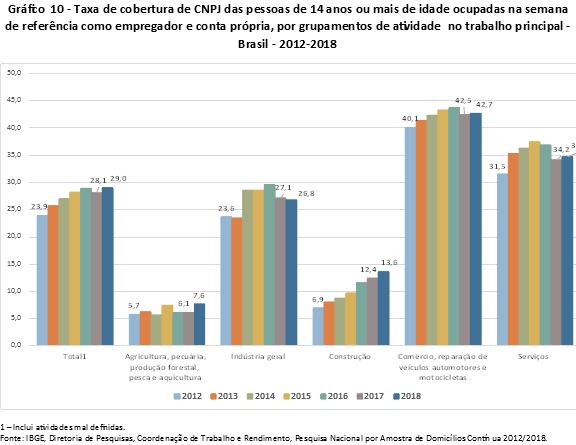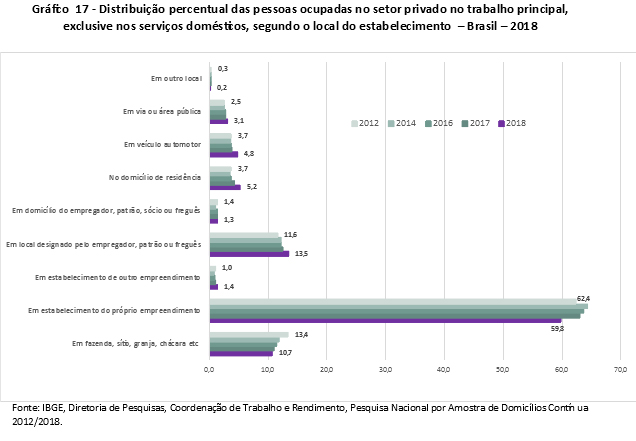In 2018, unionization falls in all categories and activities and reaches the lowest level in seven years
December 18, 2019 10h00 AM | Last Updated: December 19, 2019 10h23 AM
In 2018, of the 92.3 million employed persons, 12.5% (11.5 million persons) were union members, which represents the lowest percentage of unionization since 2012. Compared to 2017, when the rate was 14.4%, there was a reduction of 1.5 million unionized workers in the country.
The highest unionization rate in 2018 was among public sector workers (25.7%), followed by private sector workers with a formal contract (16%). Workers without a formal contract in the private sector had one of the lowest unionization estimates (4.5%). Self-employed workers, in turn, had a rate of 7.6%.
All categories had a reduction in the unionization rate in the time series. The biggest drop was that of employer, which went from 15.6% in 2017 to 12.3% (-3.3 pp) in 2018, followed by private sector workers with a formal contract, down 3.1 pp.
The rate of unionization fell for all ranges of schooling, but the higher the level of education, the higher the rate of unionization. The lowest percentage was among complete and incomplete elementary school workers (8.1%). Even registering the largest drop in 2018, the employed with complete higher degree had the highest percentage of unionization (20.3%).
All Major Regions showed a reduction in the percentage of union membership in 2018. Both in the North and the Central-West, the number of unionized workers dropped by 20% (down 180,000 and 192,000, respectively). In the Southeast, the retraction of that contingent was 12.1% (683 thousand less union members). In the South, the percentage of union members (13.9%), for the first time in the entire survey series, was below that of the Northeast Region estimate (14.1%). In 2018, the percentages of unionization by Major Regions were: North (10.1%), Northeast (14.1%), Southeast (12.0%), South (13.9%) and Central-West (10.3%).
Of the 27.9 million workers who were employers or self-employed, 5.6% (1,556,000 persons) were affiliated with the labor or production cooperatives in 2018.
In 2018, 29.0% of employers or self-employed were in enterprises registered with the CNPJ. Among the self-employed, 19.4% were registered, the highest estimate in the series; among the employers, the figure was 79.4%.
As to the place of work, in 2018, there was growth of activities performed in motor vehicles, at home and in a place designated by the employer or customer. The highest increases were at home (from 3.7% to 5.2%) and in a motor vehicle, which rose from 3.7% to 4.8% and at a place designated by the employer, boss or customer (12.5%). to 13.5%).
The complete results and support material of the Continuous PNAD: Additional Characteristics of Labor Market are on the right of this page.
Employment grows in 2018, but unionization percentage is the lowest since 2012
In 2018, of the 92.3 million persons employed in the week of reference of the survey, 12.5% (11.5 million persons) were union affiliates. his is the lowest unionization estimate since the beginning of the time series, in 2012.
With a 16.1% estimate in 2012, union membership intensified the downward trend as of 2016, when there was a decrease of 7.4% (1.1 million persons) in the number of members, reducing the proportion of unionized workers to 14.9%.
In 2017, despite the slight recovery of the employed population, the number of union members remained falling, reaching a percentage of 14.4%. In 2018, the significant employment expansion (over 1.3 million persons) did not lead a growth of unionization (which registered 1.6 million persons less); which resulted in the lowest percentage of unionization (12.5%) since 2012.
In regional terms, the drop in the unionization rate was widespread between 2017 and 2018. In both the North and the Central-West, the drop in the number of unionized workers was 20% (180 thousand and 192 thousand persons less, respectively). In the South, the percentage of union members (13.9%), for the first time in the entire series of the survey, was below the Northeast Region estimate (14%). In 2018, the percentages of unionization by Major Regions were: North (10.1%), Northeast (14.1%), Southeast (12.0%), South (13.9%) and Central -West (10.3%).
Public sector leads unionization, but rate drops
The highest unionization rate in 2018 was among public sector employees (25.7%). This group represented 12.0% of the employed population. Next were the private sector employees with a formal contract (16.0%), who had the largest share of the employed population in 2018 (36.6%). The self-employed unionization rate fell from 8.6% to 7.6%. This group represents the second largest participation in the employed population (25.4%).
Workers without a formal contract in the private sector, who represent 12% of the employed population, had one of the lowest unionization rates, falling from 5.1% in 2017 to 4.5% in 2018. The lowest estimate was that of domestic workers, going from 3.1% in 2017 to 2.8% in 2018.
Compared to the time series, the largest drop in unionization occurred among employers, whose rate went from 18.6% in 2012 to 12.3% in 2018 (-6.3 pp). Next, the rate of private-sector workers with a formal contract fell from 20.9% in 2012 to 16% in 2018 (-4.9 pp); and self-employed workers fell from 11.3% in 2012 to 7.6% in 2018 (-3.7 pp).

Unionization rate of Industry fell from 21.1% to 15.2% in six years
In 2018, by groups of activity, Public administration, defense and social security, education, human health and social services had the highest unionization rate (22.0%). Then, Agriculture, livestock, forest production, fishing and aquaculture had unionization rates of 19.1%.
In the general industry, 15.2% of its employed persons were union members, down 2.1 pp from 2017 (17.1%). Transportation, storage and mailing, with 5.1% of the total number of employed persons, had a unionization rate of 13.5%, a decrease of 4 pp. Trade, repair of motor vehicles and motorcycles had a unionization rate (8.1%) lower than the total employed population rate (12.5%).

Unionization falls more among workers with a high degree
In 2018, the lowest percentage of union members was among workers with complete elementary and incomplete elementary school (8.1%), while the highest occurred among those with a higher degree (20.3%). Compared with 2017, there was a drop in union membership at all levels of education, with the highest among graduated workers, rising from 24.2% in 2017 to 20.3% in 2018.
Compared to 2012, despite the growth of employed persons with complete secondary education and incomplete higher education, the percentage of union members in this schooling range went from 16.3% in 2012 to 11.5% in 2018. With increasing participation, the number of workers graduated went from 14.4% of the total employed in 2012 to 19.9% in 2018. But the percentage of unionization in this group fell from 28.4% in 2012 to 20.3% in 2018 - corresponding to a drop of 8.1 percentage points.

CNPJ registration grows again, but coverage among employers is still four times higher than among self-employed
In 2018, 19.4% of the self-employed persons had CNPJ, the highest estimate in the series; among employers the coverage was 79.4%.
Both among self-employed workers (4.8%) and employers (37.6%), Agriculture, livestock, forestry, fisheries and aquaculture activity had the lowest CNPJ coverage in 2018. On the other hand, Trade and repair of motor vehicles and motorcycles reached the highest percentage for both cases (28.0% and 88.5%, respectively).
Considering both the self-employed and employers, the CNPJ coverage rate was higher in Trade and repair of motor vehicles and motorcycles (42.7%); while in Services it was 34.7%. CNPJ coverage did not expand in General Industry: it fell from 27.1% to 26.8%. In Construction, the indicator went from 12.4% (2017) to 13.6% (2018) and in Agriculture, livestock, forestry production, fishing and aquaculture there was the main growth: from 6.1% to 7.6%.

In relation to the time series, as of 2012, the percentage of employed persons as employer or self-employed persons who were in enterprises registered with the CNPJ grew, reaching 29.0% in 2016. In 2017, it decreased to 28.1%, growing again in 2018 (29.0%) and returning to the same value as that of 2016 (29.0%).
The North (13.4%) and Northeast (16.3%) Regions had the lowest coverage, while in the South the estimate was 39.8%. Compared to 2017, only the Central-West had a retraction in the CNPJ from 31.7% to 30.5%. Compared to 2012, the largest growth in the percentage of CNPJ registration occurred in the Northeast, reaching 38%.
Formalization increases proportionally to schooling
While only 9.0% of self-employed workers who were uneducated or had incomplete elementary education were registered with the CNPJ, 42.8% of graduated self-employed workers were registered. Among employers a similar dynamic occurred. However, in the case of uneducated and incomplete elementary employers, the CNPJ coverage rate (52.9%) surpassed that of self-employed persons with a degree (42.8%).
Cooperative affiliates are 5.6% among employers and self-employed
Of the 29.9 million persons employed as employers or self-employed, 5.6% (1.6 million persons) were associated with a labor or production cooperative in 2018. This estimate kept the downward trend begun in 2015. The highest indicator value (6.4%) occurred in 2012.
Even with the highest estimate, the South Region had the main negative change, from 10.3% in 2017 to 9.5% in 2018; On the other hand, the Central-West registered an increase in the number of cooperative members, with a rise of 23,000 persons in the period, increasing the percentage from 4.9% to 5.8%.
Work at vehicles, households and places designated by boss or customer grows
Regarding the workplace, there was a growing trend of activities on public roads, motor vehicles and at home, reflecting the changes introduced by the new economy of the country. The largest increases were in households (from 3.7% to 5.2%) and in motor vehicles, which rose from 3.7% to 4.8%.
The population employed in the private sector in Brazil (74.4 million persons) in 2018, worked mainly in the facilities of the enterprise itself (59.8%), a decrease of about 1.8 million persons as compared to 2017, resulting in 44.5 million persons. Working at a place designated by the employer, boss or customer grew from 11.6 in 2012 to 13.5% in 2018.
Farms and ranches as workplaces have fallen sharply over the past six years, dropping from 13.4% to 10.7% - accounting for 8.0 million persons.



